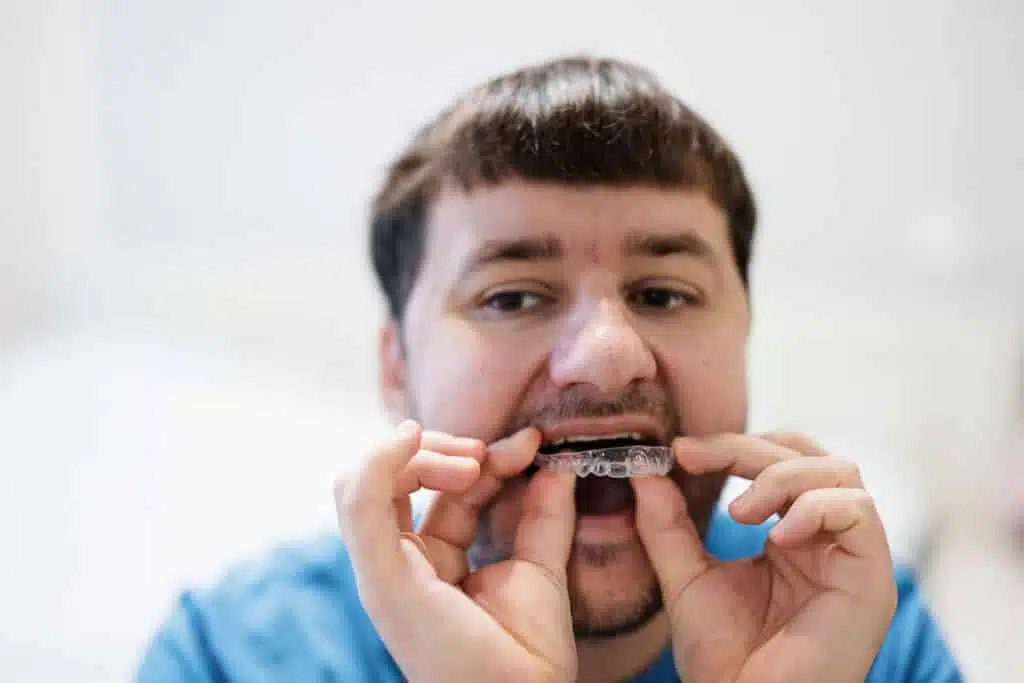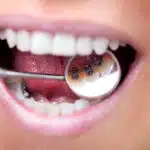How quickly do teeth shift with braces? This article tells you when you can expect the first results.
Braces can be a life-changing treatment when it comes to correcting misaligned teeth.
While it is essential to understand that the rate at which teeth shift with braces depends on various factors, we can still look at some general guidelines.
In this article, we will look in-depth at the question, “How quickly do teeth shift with braces?”
| Get 150 € discount on your dental correction! |

Book a consultation appointment now at a nearby DrSmile partner practice and determine if teeth straightening with aligners is right for you.
The appointment is completely non-binding and does not involve any costs.
With the code “THATSMILE150” you will receive 150 € discount on the treatment.
What exactly is a brace?
A brace is an orthodontic appliance to correct misaligned teeth and jaw anomalies.
It consists of metal clasps, bands, and fixed or removable wires on the teeth.
The goal of braces is to gradually change the position of the teeth and achieve proper alignment.
The alignment of teeth plays a vital role in overall oral health.
Aside from aesthetic reasons, improper tooth alignment can lead to problems such as tooth decay, gum disease, jaw problems, and even speech impediments.
Braces offer an effective solution to correct these problems.

What are the types of braces?
Different types of braces can be selected depending on individual needs and preferences. Here are some of the most common types:
1. fixed braces
Fixed braces are the most traditional type of braces. It consists of metal clasps glued to the teeth and a wire connecting the clasps together.
The braces exert constant pressure on the teeth, allowing gradual movement.
2. loose braces
Loose braces are often used on children because they are easier to clean and maintain.
It consists of a plastic body with wire elements and can be removed by the patient.
However, this type of braces can only make limited corrections and requires high discipline to wear them regularly.
3. invisible braces (aligners)
Invisible braces consist of transparent, custom-made splints that are placed over the teeth.
They are almost invisible and can be easily removed for eating and brushing teeth.
Since providers such as DrSmile use advanced technology, aligners are effective, painless, and relatively inexpensive.
Factors influencing the speed of tooth displacement
The speed at which teeth shift with braces varies from person to person. However, some key factors can influence this speed:
1. age
The patient’s age plays an important role in the speed of tooth displacement.
Children and adolescents usually have a higher bone turnover rate, meaning their teeth can move faster than adults.
Nevertheless, adults can also achieve successful results with braces, although the treatment may take a little longer.
2. type of brace
The type of braces used can also affect the speed of tooth shifting.
Fixed braces usually create a constant force, while removable braces may exert less pressure.
Aligner treatments are often suitable for mild to moderate malocclusions and can therefore take a little less time.
3. severity of the malposition
The severity of the malocclusion directly affects the duration of treatment.
The larger the correction, the longer it usually takes to achieve the desired results.
Your orthodontist can give you a realistic estimate of how long your specific treatment will take.
4. compliance with the gestation period
The regular and consistent wearing of braces is critical to the success and speed of tooth shifting.
If you do not wear your braces adequately, this can significantly extend the treatment time.
It is important to follow the orthodontist’s instructions and use the braces for the recommended daily wearing time.
| Get 150 € discount on your dental correction! |

Book a consultation appointment now at a nearby DrSmile partner practice and determine if teeth straightening with aligners is right for you.
The appointment is completely non-binding and does not involve any costs.
With the code “THATSMILE150” you will receive 150 € discount on the treatment.
Braces: How quickly do teeth shift?
The average duration of treatment with braces usually varies between 18 and 36 months.
However, this time may be shorter or longer depending on individual factors.
Regular visits to the orthodontist are recommended during treatment to monitor progress and make adjustments as necessary.
It is important to note that the speed of tooth displacement should not be reduced to the duration of treatment alone.
Each patient responds differently to treatment, and individual variations may occur. Therefore, it is important to be patient and follow your orthodontist’s instructions.
Tips for faster tooth shifting
If you want to maximize the speed of tooth shifting with braces, you should follow these tips:
1. maintenance of good oral hygiene
It is important to clean your teeth thoroughly and maintain good oral hygiene while wearing braces.
This helps prevent plaque and tooth decay and ensures your teeth stay healthy.
2. following the instructions of the orthodontist
Your orthodontist will give you specific instructions on how to wear and care for your braces.
It is important to follow these instructions carefully to achieve optimal results and shorten the treatment time.
3. maintain a balanced diet
A balanced diet is important for the health of your teeth and can also influence the speed of tooth shifting.
Ensure you are consuming enough important nutrients for bone and tooth development.
4. avoid sticky and hard food
Certain foods, such as caramel, chewing gum, and hard candies, can cause braces to loosen or damage.
Avoid these foods during treatment to prevent unwanted delays.

Potential challenges during braces treatment
Some challenges may arise during braces treatment.
It is important to be aware of these challenges and take appropriate measures to deal with them:
1. discomfort and pain
It is usual for your teeth to feel a little sensitive at first after the braces have been fitted or adjusted.
This discomfort usually subsides within a few days. You may also experience pain when your orthodontist adjusts or tightens braces.
However, wearing braces should generally not be painful. If you have persistent pain, you should consult your orthodontist.
2. language difficulties
It may take some time to get used to speaking normally with braces.
You may have problems pronouncing certain sounds or words in the first few days.
Over time, your tongue will get used to the presence of the braces, and your pronunciation will normalize.
3. adjustment to the brace
It may take some time for your mouth to get used to wearing braces.
For the first few days, your cheeks and lips may feel slightly irritated as they adjust to the braces.
However, with time your mouth will get used to the braces, and the discomfort will decrease.

Importance of aftercare
Once braces treatment is complete, proper aftercare is critical to maintain the results achieved over the long term.
This is because braces are not always cheap, so you may want to do the treatment only once if possible. Here are some important aspects of follow-up care:
1. retainer
After removing braces, a retainer is usually recommended to ensure that your teeth do not shift again.
A retainer is an orthodontic appliance used to maintain the achieved alignment of the teeth.
It is important to wear the retainer regularly, according to your orthodontist’s instructions.
2. follow-up examinations
Regular follow-up visits with your orthodontist are important to monitor the condition of your teeth and the stability of the results.
Your orthodontist will let you know how often you should have these exams.
3. long term care
It is important that you maintain good oral hygiene even after the treatment is completed.
Brush your teeth twice daily, floss, and visit the dentist regularly to ensure your teeth and gums stay healthy.
Overall, the duration of tooth shifting with braces can vary depending on various factors such as age, type of braces, severity of misalignment, and adherence to wearing time.
It is important to be patient and carefully follow the orthodontist’s instructions for best results.
Talk to your orthodontist about your specific situation. He will be able to give you the best advice.
| Get 150 € discount on your dental correction! |

Book a consultation appointment now at a nearby DrSmile partner practice and find out if teeth straightening with aligners is right for you.
The appointment is completely non-binding and does not involve any costs.
With the code “THATSMILE150” you will receive 150 € discount on the treatment.
FAQs on the topic: How quickly do teeth shift with braces?
At this point, we will answer some frequently asked questions about the topic “How quickly do teeth shift with braces?
Is braces treatment painful?
Braces treatment may cause discomfort and mild pain at first as the teeth adjust to the braces. In most cases, however, the discomfort is minimal and subsides within a few days.
Can I eat normally with braces?
Yes, you can usually eat normally with braces. However, avoiding sticky and hard foods is recommended to prevent damage to the braces. Your orthodontist will give specific recommendations on what foods to avoid during treatment.
Can I do sports during braces treatment?
Yes, you can do sports during braces treatment. However, for high-contact sports, wearing a mouthguard to protect teeth and braces from injury is recommended. Talk to your orthodontist about the best option for a mouthguard.
How long should I wear my retainer?
The recommended wearing time for a retainer may vary from case to case. It is usually recommended to wear the retainer regularly for a certain period of time after the braces treatment is completed. Your orthodontist will give you precise instructions.
How can I clean my teeth during braces treatment?
It is important that you clean your teeth thoroughly while wearing braces. Uses a soft toothbrush and carefully cleans the teeth around the braces. Supplement your oral hygiene with dental floss and possibly a mouthwash to achieve optimal cleaning.



Leave a Reply